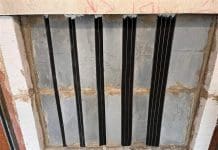David Parr, policy and technical director at the British Safety Council, examines the final recommendations of the Hackitt Review into fire safety and building regulations
On 14 June 2017, a catastrophic fire at Grenfell Tower in London claimed the lives of 71 people and deprived hundreds of others of their homes and possessions. The impact was felt across the world and the government committed to urgent action to ensure that such a tragic event would not happen again.
The British Safety Council welcomed the publication of the final report resulting from the inquiry led by Dame Judith Hackitt: Building a Safer Future, Independent Review of Building Regulations & Fire Safety.
Throughout the report, recommendations draw on principles established under the Health & Safety at Work Act. We welcome this approach and encourage the government to extrapolate this effective and proven regime to inform the developing theme of residents’ safety. We feel that the adoption of a risk-based goal setting model is entirely appropriate and will underpin proportionality and flexibility in the regime.
Although we appreciate that it is sensible to roll out any new regime gradually, and that high-rise residential buildings represent the area of greatest risk, we urge the government to set an ambitious timeline for a second phase of work that will extend the scope to cover other multi-occupied residential buildings, particularly those housing vulnerable individuals, and to institutional buildings.
Ultimately, we would like to see the proposed regime extended to apply proportionately and consistently across all types of buildings.
The British Safety Council welcomed several of the report’s recommendations including:
- The establishment of a joint competent authority (JCA) to oversee fire and building safety.
- Application of a systems-based approach to the safety of buildings throughout their whole lifecycle.
- Consideration of fire prevention at every stage of design, and a layered approach to protection.
- Application of the outcome-based model for building safety. It promotes flexibility, proportionality and adaptability in the regulatory framework.
- Identification of duty-holders at each stage of the building lifecycle, together with their associated responsibilities and accountabilities.
- Extension of the regime to cover operation and maintenance as well as design and construction of buildings.
- Strengthening of the sanctions regime as part of the new framework and support application of a model similar to that set out in the Health & Safety at Work Act.
- The call for a digital record to serve as a lifelong log for each building, acting as a single point of assured building-related information.
- The proposal for interaction with international building safety groups.
At the same time, however, the British Safety Council had concerns regarding the following issues:
Regulatory framework
We are concerned about the practicalities of the proposed establishment of a joint competent authority (JCA) to oversee fire and building safety. This would require collaborative working across three separate regulatory functions and three responsible government departments when resources are already somewhat limited.
We are also concerned about the proposed funding through a cost-recovery programme. There is a widespread feeling that the HSE’s fee for intervention programme has significantly changed relationships with duty holders and fundamentally damaged a proactive approach to regulation. We accept that a source of funding will be required for the new body but urge government to consider direct funding rather than cost recovery in order to expedite implementation.
Design, construction and refurbishment
The British Safety Council welcomes suggestion that any new regime should mirror that set out in the Construction Design & Management Regulations (CDM). This is established, effective and understood across the building sector, and addresses many of the issues identified in the report. As such, it would provide a robust context for many of the recommendations made by the review.
We have concerns about the effectiveness of ‘selfcertification’ schemes relating to certain aspects of building standards, and fully endorse and encourage appropriate regulatory oversight in respect of this issue.
We agree that the sanctions regime needs to be strengthened as part of the new framework and propose that the current sentencing guidelines for health and safety offences should also be extended to cover fire and building safety. This will provide a consistent approach and emphasise the significance of the duties imposed by the new regime.
Guidance and monitoring
We have significant concerns about making this the sole responsibility of industry bodies and consider that it would be more effective to adopt a model whereby regulations are produced by government, while approved codes of practice and guidance by the regulator in collaboration with industry stakeholders.
Golden thread of building information
The British Safety Council supports the call for a digital record to serve as a lifelong log for each building, acting as a single point of assured building-related information. However, we do have some concerns about the implementation of this recommendation, as the public sector has a somewhat inconsistent record for rollout of large-scale technology projects, and care should be taken to apply previous learning to inform this work.
Combustible material in cladding systems
Following the publication of the report, there has been much discussion about the fact that it does not recommend a ban on the ACM cladding material used at Grenfell Tower. To impose a ban on this one type of cladding would drive compliance, but only in relation to this one product. It would do nothing to pre-empt problems not yet identified with other
The review goes further than this. It proposes a new and more stringent system for testing and certification of materials, not in isolation, but as part of the system in which they are to be used. In relation to existing buildings and those under refurbishment, the review recommends application of a safety case system, and a duty to review fire and building safety and seek to make improvements throughout the lifecycle of the building.
So, rather than proposing a short-term fix to a single issue, the review proposes a system-level adjustment that should prevent a situation in which any combustible product could be included in a building in a way that might compromise fire or building safety. It also proposes a regulatory system to monitor compliance.
The British Safety Council supports the consultation regarding a ban on the identified cladding as a short-term measure.
We do, however, believe that the regime change proposed in the Hackitt review is the right solution to address the systemic failures that allowed this cladding to be installed in the particular configuration at Grenfell. This would prevent as yet unknown issues from becoming serious hazards in the future.
Conclusion
The British Safety Council welcomes the publication of this important report, and notes that it is the culmination of a significant research and engagement project.
The recommendations are ambitious and far-reaching, but on balance we feel that they set the right tone for a new regulatory system that will be fit for purpose in modern day UK.
We await the government response to the recommendations of the Hackitt review and are committed to supporting the process of implementation in any way that we can.
The fire at Grenfell Tower was truly horrific and we must all do whatever is necessary to ensure that such an event can never occur again.
David Parr
Policy and Technical Director
British Safety Council
Tel: +44 (0)20 3510 8355
Twitter: @BritSafe
LinkedIn: British Safety Council




![[VIDEO] Making DorTrak reports easy to read with Fireco Inspecting fire doors at Fireco, firedoor technology, 2023](https://www.pbctoday.co.uk/news/wp-content/uploads/2024/04/JPZ_2364-web-218x150.jpg)









